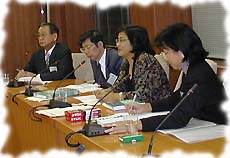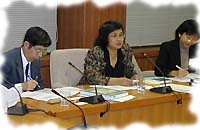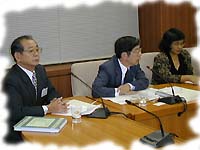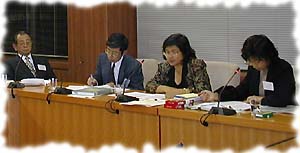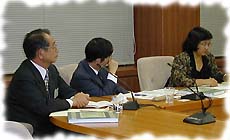Other
FY1999:Micronesia and Education: The Future
| Category |
Other |
| Year of Publication |
1999.02 |
| Author/Editor |
Elizabeth D. Rechebei
Northern Mariana Islands |
| Note |
Paper presented on 12/2/99 at a Seminar
Sponsored by Sasakawa Peace Foundation
Tokyo, Japan |
Micronesia and Education: The Future
One of the most far-reaching influences from the outside that Micronesia wholeheartedly absorbed is the system of formal education. While four nations have implanted their own unique philosophies of education for the islands, the people of Micronesia have approached education as a democratic process in itself--that all, regardless of status or family background or affluence, will have the right to be educated.
The future bodes uncertainties for education in Micronesia. While the global economies and modern technology are translating the nature of the future workforce, Micronesia is caught in a dilemma regarding its future plans for education and how it could afford to make those plans a reality.
This is a very special opportunity for me to share with you my thoughts about a very important topic: education in Micronesia. Before I go into the topic in detail, from the onset, I am deeply grateful to Mr. Akira Iriyama, President of Sasakawa Peace Foundation, and to Ms. Rieko Hayakawa, Project Officer and my first contact with the Sasakawa Foundation. The privilege to join many other Pacific islanders in participating in this kind of event is indeed an honor.
I have been to Japan on several occasions but not as often as I would like to. This is my first opportunity again in two years since when I attended the Kyoto Climate Change Conference. I have special personal feelings about Japan. My ancestry is partly Japanese as my mother is Japanese from Hokkaido now living in Saipan. My father is an islander from Saipan, educated in Japan before WWII, and experienced the war in Japan. He and my mother left Japan in 1946 and came to Saipan. Coming to this part of Japan was an emotional experience for me because my father went to school at Kogyo Fuzoku Gakko. I will be meeting some of his classmates to visit the school he attended. Both, my father and mother are now over 70 years old.
I was born and raised in Saipan, attended a Catholic elementary and high school, went off-island for college education and obtained a bachelorェfs degree in psychology and a masterェfs degree in educational psychology. To keep my mental faculties in tune, I took the impulse to enroll in a doctoral program in the area of leadership and education out of the University of San Diego in collaboration with San Diego State University. Here is a pilot project on collaboration to keep in mind. I worked as an educator in Micronesia for more than fifteen years and was the first female Micronesian to become the head of education in the region. I was also the first female to head the department of education in the Commonwealth of the Northern Mariana Islands. It is without a doubt that one of the most rewarding experiences of my professional life was my work and interaction with the people of Micronesia. This is an experience that not many people will have since the disintegration of the former regional grouping of the islands under the Trust Territory Administration by the United States.
Presently, I am working as a private consultant on social and education issues. My connection with the Sasakawa Peace Foundation is as a semi-volunteer in a unique project funded by Sasakawa--Transcending Borders with Education On line. This project is under the auspices of the Micronesian Seminar in Pohnpei, Federated States of Micronesia. The project reaches out to the world community through its services in the areas of publications, videotapes, library services and the forum discussions on issues affecting Micronesia today.
Micronesia, surprisingly, is still not a well-known region in the world. Even prior to WWII, Micronesia to the United States was a ェglargely unknown territoryェh (Kiste, 1999). It is fair to say that while not many people know about Micronesia, Micronesians generally know a great deal more about the rest of the world. How this came about is through the educational processes that were in place during the colonial eras starting with the Spanish, then the Germans, Japanese, and finally, the United States of America. As a result, a natural curiosity emerged about the people who came to the islands and have made a deep impact on the lives of the islanders.
To add to this phenomenon, the instructional materials that later dominated the curriculum in the islands were mostly about the outside world and hardly anything relating to the islands themselves. This was understandable due to the circumstances of the times. During the Spanish administration of the islands that lasted for about three hundred years in the Marianas, religion was the focus in order to Christianize the people. The first school for boys was opened in Guam in 1669. An attempt at free education was later made but did not last. The Germans were the first to start a public education program. Attendance was mandatory for all children ages six to thirteen. Germanyェfs focus in education was in transforming the cultural characteristics of the people that were not conducive to an ordered and disciplined way of life. Personal achievement and accumulation of wealth through hard work were emphasized. (Just as an aside, the CNMI celebrated the 100th anniversary since the Germans came to the Marianas last week on November 17th.)
Japan's entry into Micronesia began with trading even before the Germans took over Micronesia. Upon the formal occupation by Japan, the naval command established the first public school system with Japanese language as the main curriculum along with some singing and arithmetic. It was during the Japanese administration that education became more solidly entrenched. Compulsory education was established for up to three years with options for two more years.
For the first time in Micronesia, schools were opened in all the six island groups. By then, education was viewed by Micronesians as the key to prestige, power and material wealth. It has been written that right after the end of the war, the people in Palau started rebuilding their schools as the top priority. This was the culminating influence of the three nations that colonized Micronesia with Japanェfs influence being the most effective. By 1918, there were 1,700 students throughout Micronesia attending the three-year education program. Christian missions were also encouraged because the Japanese administration felt that they were a good influence to the islanders.
Eventually, three years of formal education for children aged 8 to 14 for six hours a day was the standard. Japanese language, calisthenics, moral education, arithmetic, geography, and vocational education were part of the curriculum. The goal of education then was to prepare the islanders to assimilate Japanese value systems. Logistics difficulties prevented the education of children in the most remote islands although efforts were made to bring these children to the main islands. At least half of the school-age population was enrolled_a major accomplishment considering the logistic and technology at that time. Palau enrolled almost 100% of its school-age population.
In the 1930s as more Japanese immigrants came to the islands, their children came with them. Japanese children were taught in different schools with their own teachers completely separate from the island children. The islanders were provided a three-year program with an additional two-year option thereafter; the Japanese were provided with a six-year program with a two-year option afterward.
However, even one Japanese himself stated that the islanders were being trained to be loyal and useful to the Japanese cause. Regardless, to the islanders, education was something more meaningful as far as they were concerned. It goes without saying that the islanders consider that education is very important if they are to participate even at the edge of prosperity in those days. It is the vehicle for interacting and understanding foreigners which generally led to participation in the world of the foreigners who were in control.
Not so long after the end of WWII, the islanders begged the US administrators to rebuild their schools even before their own homes went up. Schools were opened in almost all the islands and in less than three years after the war, there were more schools in Micronesian than during the Japanese administration. Not surprising, even during the early US education efforts, it was once again the ideals and values of the United States that were taught. Instructional materials were lacking except for used books that were again very foreign to the islanders. As different US administrators came to the islands, different philosophies of education followed them. At one point the US philosophy was to have Americans teach Micronesians how to teach other Micronesians.
Schools were disorganized then and instructional materials were inappropriate. Micronesian teachers were not trained until the teacher training centers were established in each of the major islands. The highest training facility was in Chuuk adding three more years of education for teachers.
The effect of this early education system was a group of Micronesians who entered the labor force and were also hired in government. They became the first group of trained teachers in Micronesia and many of them later assumed political and government leadership positions.
In the mid-1960s, the arrival of Peace Corps volunteers in Micronesia made a dent in the English language instruction as well as in the political aspirations of the people. The US had already begun to put in millions of dollars into educating the people of Micronesia. By then, education was clearly seen as the road to success, prestige and money. Present day Micronesia has universal education mandated for the elementary level up to the 8th grade level. High School is also practically mandatory if not necessary, and college as the logical step toward finding a better job. Micronesians believe that without a college education nowadays, finding a good job will be quite difficult if not impossible.
This brings to question the reality of education in a far-flung group of islands of Micronesia. While small in population relatively speaking, all the Micronesian entities now have their own community colleges in addition to the many public and private schools from kindergarten to high school_a total of 13 years of education for the population, plus two or three more years of postsecondary education. The US system of education is the norm now in Micronesia. Standards and new fads in education introduced in the United States quickly find their way into Micronesia by way of conferences, workshops, consultants, and congressionally funded regional educational centers that serve as the conduit for education initiatives in the US. Textbook and test publishers regularly make their rounds through the islands and much more importantly, US federal grants continue to have a major influence on what programs will be implemented in the schools.
At present, the budget for education remains one of the highest in almost all of the Micronesian governments if not the second highest. However, it is still not enough to provide adequate facilities, well trained and well paid teachers, enough instructional materials, etc. Even with US federal assistance in the millions of dollars, and whatever foreign assistance becomes available, the schools in Micronesia are in need of properly trained teachers, accountable administrative systems, and more relevant educational programs. Alignment with the US national goals is an ongoing concern as attainment of these goals presupposes existence of adequate support systems for proper delivery of instruction. Continuing reliance on outside financial assistance for instructional materials and other educational services prevents implementation of programs responsive to the needs of the people. In most systems, the local funds are barely enough to support personnel costs, much less instructional materials and related needs.
Assessing the achievement level of students in Micronesia is a dilemma. Since the system is patterned after the US educational system, US tests are generally used to determine student achievement and thereby, compared with US averages. Lack of expertise and funds also prevent development of more appropriate standardized tests for most of the islands. Micronesians know that US tests are not all appropriate, but they still want to be compared with the US.
Running a public education system in any country is extremely expensive especially if you want to do a good job at it. Patterning it after a system that is not really all that appropriate is even more expensive. While everyone wants education, the question of what is appropriate education for Micronesia is constantly being raised. The usual recommendations are to educate so that the people will become contributing members of the Micronesian society; to educate so that Micronesians can compete as well as anybody in the global economy; to educate so that we will have critical thinkers and decision makers for the emerging island nations, and so on. How these will be aligned with national priorities is a matter of great complexity. Conflicting ideals, limited resources, and the ongoing philosophical debates on how best to educate, all come into play in deciding the future of education for Micronesia.
More and more, Micronesians are relocating to other areas for better jobs and educational services. It has been estimated that about 25,000 Micronesians are now living outside of Micronesia. This is about 13% of the entire population of Micronesia (Palau, Marshalls and FSM). It is expected that more will relocate to the US affiliated entities and the US mainland for better jobs and education if the economies in the islands do not improve.
The future of education in the islands does not look too good. Putting everything in perspective, none of the island groups including my own, is able to provide quality education that respond to the peopleェfs desires. However, the prospects for meeting some of the basic needs are good at least. This is possible if federal assistance from the United States and foreign aid to support education continue. The tax dollars generated in the islands are barely enough to cover salaries only. The economy in the islands has not kept up with the costs of educating its people and the gap keeps getting larger. As the population grows, more students enter the school system and therefore, the cost of education keeps rising while the economy is not getting any better and the financial support from the US and foreign aid decrease.
So what should the future of education in Micronesia look like?
In a democratic system of government, everyone should have the right to at least basic education and in the case of Micronesia, at least up to the 8th grade level. But Micronesia now has high schools and colleges as well, and it is natural that anyone that desires further education should be able to have it especially if it is available on island. That is the present mentality among the people of Micronesia. This brings up the question of how to overcome the numerous barriers in education and in education in Micronesia in particular.
Some islands in Micronesia have less than 1,000 people while the highest population in any island group is about 73,000 not counting the FSM. One can easily imagine the insurmountable cost of running hospitals, schools, colleges, and many other services considered standard in these days and age in the many islands of Micronesia. There is necessary duplication of services in each island group in order to overcome distance. Air travel between the islands is extremely costly.
Some of these duplications of services and travel costs could be surmounted through telecommunication and collaborative systems within the region. Modern technology and communication may be the answer not only in education but also in any activity that may require access to information and learning as well as communication within and without Micronesia. In addition to that, collaborative efforts and cooperation among various sources in Micronesia and the Pacific-Asia community will lessen the cost of education while improving its overall quality. A wider networking arrangement with universities across the globe specializing in certain areas will respond to the shortage of particular expertise in Micronesia without the need to relocate or travel. Even non-educational institutions such as research institutions, think tanks and nongovernment organizations, can join the networking group to promote education in the region.
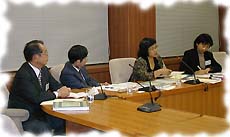
A good example is the accessibility of libraries for students. Although ideal for tourists, Micronesiaェfs climate is humid and destructive to a host of materials due to rust and mildew among others. Libraries are expensive to maintain without a reliable air conditioning system. Materials for buildings are exorbitant and poor in quality. And electricity is not easily affordable to many, even government organizations. Today, many libraries around the world are opening up their collections for worldwide access through the Internet. Teachers and other experts are conducting lessons and discussions from one end of the globe to another. Distance and time as well as expensive costs of maintaining a good library have been overcome to a certain extent in some areas. Why not take advantage of these new ways of learning? Not only is this a trend for the future in education but it is also becoming a necessity in conducting commerce. More and more, people are relying on telecommunication via the Internet to communicate and learn about the world around them as well as conduct activities relating to business and personal needs.
The most scattered and isolated groups of islands in the world can turn out to be the most in tune about the world through telecommunication and the Internet.
In the area of collaborations, there are quite a good number of organizations both government and nongovernment that can contribute toward the educational programs in Micronesia. These are the universities and colleges, research institutions, business communities, religious organizations, womenェfs groups, professional organizations, to mention a few. Again, distance learning could be used as one of the vehicles for collaborative efforts in training and instructional delivery.
The traditional system of education needs to be re-evaluated in Micronesia. More flexibility is needed in to respond to the rapid changes that are occurring globally. Not only should the basics be taught but the sciences and technology must be emphasized more. World events, environmental issues, cultural awareness, and participation in the critical analyses of these topics are important even as early as the elementary level of education. The media makes no distinction as to its audience and children are bombarded daily by the media with all these information. The students must learn from real events as well as from books and lectures.
Donor countries such as Japan, the US, Australia, etc., have been very generous in supporting many social and economic projects in the islands. In the area of education, perhaps a comprehensive review of all the bodies that have potential in increasing the education capabilities in the islands should be undertaken in order for these assistance to be more effective. The objective of this initiative would be to reassess the purposes and strengths of these bodies and how they may support quality educational practices in the region using new paradigms and technology to respond to global trends, and to prepare for unanticipated events that may result from these trends.
At the same time, the limitations of the region, the extent of technological availability, funding sources, and political issues must be put in their proper perspective in the process. Perhaps an educational conference that would bring most, if not all of these bodies together to discuss the future of education in the region will serve as a commencement toward a future of exemplary collaboration initiatives in education and a model for other similar situations.
I close with the recognition that we as a people have much to be thankful for in our relationship with other countries and cultures. Japanェfs contribution to our economy in the past fifteen years has been unprecedented particularly in the Marianas. The formal public education system Japan introduced to us over seventy years ago served as a springboard for our peopleェfs entry into the arena of international political, social, economic, and even personal achievements.
We still have much to work for to attain our goals. While we acknowledge our continuing reliance on outside assistance, we also need to endeavor to put our own best efforts forward. Education was the key to success during the colonial periods of Micronesia; it is still the key for a better life for Micronesians today. Micronesians cannot do it alone as yet. And even after 300 years of exposure to this thing called education, we continue to ask what is the best education for us and how much of it can we support without outside assistance.
Thank you for your patience and your time.

